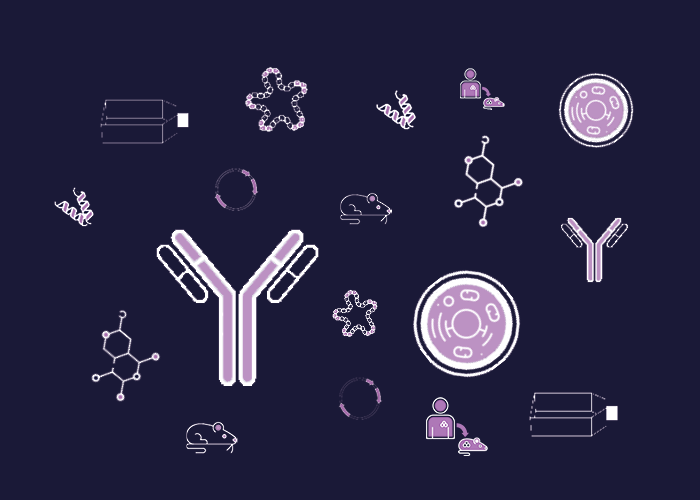Antibodies
Showing 1–25 of 2305 results
Category
Research area
Cancer type
Inventor
Institute
Availability
Reset filters
-

Monoclonal anti-RFP DsRed (DS-1A6)
£300.00 Monoclonal anti-RFP DsRed (DS-1A6)Cat. #162401
Sub-type: Primary Antibody
Target: RFP / DsRed (Red Fluorescent Protein)
Class: Monoclonal
Application: ELISA, WB, ICC
Reactivity: N/A
Host: Mouse
-

Monoclonal antibody anti GSK-3 (GSK-5G)
£300.00 Monoclonal antibody anti GSK-3 (GSK-5G)Cat. #162407
Sub-type: Primary Antibody
Target: Shaggy protein kinase family
Class: Monoclonal
Application: Immunoblotting; Immunohistochemistry : under investigation; Immunoprecipitation : not tested
Reactivity: Drosophila, NOT E.coli
Host: Mouse
-

Monoclonal antibody anti SUMO1 (SUM-1C6)
£300.00 Monoclonal antibody anti SUMO1 (SUM-1C6)Cat. #162428
Sub-type: Primary Antibody
Target: SUMO1
Class: Monoclonal
Application: ELISA, WB
Reactivity: Human, mouse
Host: Mouse
-

Monoclonal antibody anti TRAF4/MLN62 (TRAF-2H1)
£300.00 Monoclonal antibody anti TRAF4/MLN62 (TRAF-2H1)Cat. #162398
Sub-type: Primary Antibody
Target: TRAF4 / MLN62
Class: Monoclonal
Application: ELISA, WB, IHC, ICC
Reactivity: Human, mouse
Host: Mouse
-

Monoclonal antibody anti-acetyl Histone H3 (H3-1A5)
£300.00 Monoclonal antibody anti-acetyl Histone H3 (H3-1A5)Cat. #162391
Sub-type: Primary Antibody
Target: acetyl-Histone H3 (Lys 14)
Class: Monoclonal
Application: ELISA, WB, IF, IP, ChIP
Reactivity: Sequence conserved in wide range of species
Host: Mouse
-

Monoclonal antibody anti-acetyl Histone H4 (H4-2C2)
£300.00 Monoclonal antibody anti-acetyl Histone H4 (H4-2C2)Cat. #162392
Sub-type: Primary Antibody
Target: acetyl Histone H4
Class: Monoclonal
Application: ELISA, WB, IP, IF
Reactivity: Sequence conserved in wide range of species
Host: Mouse
-

Monoclonal antibody anti-Acetylated (K12) Histone H4 (H4-4C10)
£300.00 Monoclonal antibody anti-Acetylated (K12) Histone H4 (H4-4C10)Cat. #162415
Sub-type: Primary Antibody
Target: acetylated (K12) Histone H4
Class: Monoclonal
Application: ELISA, WB, immunoprecipitation
Reactivity: Sequence conserved in wide range of species
Host: Mouse
-

Monoclonal antibody anti-CRABPII (CRA-3B3)
£300.00 Monoclonal antibody anti-CRABPII (CRA-3B3)Cat. #162399
Sub-type: Primary Antibody
Target: CRABPII (Cellular retinoic acid binding protein II)
Class: Monoclonal
Application: ELISA, WB, IHC, ICC
Reactivity: Mouse and human
Host: Mouse
-

Monoclonal antibody anti-DAX-1 (DAX-2F4)
£300.00 Monoclonal antibody anti-DAX-1 (DAX-2F4)Cat. #162400
Sub-type: Primary Antibody
Target: DAX-1 (NROB1)
Class: Monoclonal
Application: ELISA, WB, IHC, ICC, immunoprecipitation
Reactivity: Human, mouse, rat
Host: Mouse
-

Monoclonal antibody anti-dimethyl (K14) Histone H3 (H3-2B10)
£300.00 Monoclonal antibody anti-dimethyl (K14) Histone H3 (H3-2B10)Cat. #162410
Sub-type: Primary Antibody
Target: dimethyl (K14) Histone H3
Class: Monoclonal
Application: ELISA, WB, immunoprecipitation
Reactivity: Sequence conserved in wide range of species
Host: Mouse
-

Monoclonal antibody anti-Dimethyl (K9)-Phospho (S10) Histone H3 (H3-2C5)
£300.00 Monoclonal antibody anti-Dimethyl (K9)-Phospho (S10) Histone H3 (H3-2C5)Cat. #162411
Sub-type: Primary Antibody
Target: dimethyl (K14) Histone H3
Class: Monoclonal
Application: ELISA, WB, IF, immunoprecipitation
Reactivity: Sequence conserved in wide range of species
Host: Mouse
-

Monoclonal antibody anti-Dimethyl K-PhosphoS Histone H3 (H3-2H12)
£300.00 Monoclonal antibody anti-Dimethyl K-PhosphoS Histone H3 (H3-2H12)Cat. #162412
Sub-type: Primary Antibody
Target: Dimethyl K-PhosphoS Histone H3
Class: Monoclonal
Application: ELISA, WB, IF, immunoprecipitation
Reactivity: Sequence conserved in wide range of species
Host: Mouse
-

Monoclonal antibody anti-ETS-1 (ETS-7F2)
£300.00 Monoclonal antibody anti-ETS-1 (ETS-7F2)Cat. #162404
Sub-type: Primary Antibody
Target: ETS-1 (DNA Binding Domain)
Class: Monoclonal
Application: ELISA, WB, IF
Reactivity: Human, mouse
Host: Mouse
-

Monoclonal antibody anti-FUS/TLS (FUS-1D2)
£300.00 Monoclonal antibody anti-FUS/TLS (FUS-1D2)Cat. #162405
Sub-type: Primary Antibody
Target: human FUS/TLS
Class: Monoclonal
Application: ELISA, WB, IHC, ICC, immunoprecipitation
Reactivity: human
Host: Mouse
-

Monoclonal antibody anti-Gal 4 (GV-3)
£300.00 Monoclonal antibody anti-Gal 4 (GV-3)Cat. #162408
Sub-type: Primary Antibody
Target: Gal 4 (DNA Binding Domain)
Class: Monoclonal
Application: ELISA, WB, ICC, IP, Supershift experiments
Reactivity: Human
Host: Mouse
-

Monoclonal antibody anti-GSK-3 (GSK-4G)
£300.00 Monoclonal antibody anti-GSK-3 (GSK-4G)Cat. #162406
Sub-type: Primary Antibody
Target: GSK-3 / Shaggy protein kinase family
Class: Monoclonal
Application: WB, IHC, weak in immunoprecipitation
Reactivity: Drosophila, should also cross react with all species homologues. Cross-reacts effectively with rat, Sch. Pombe, Dictyostelium
Host: Mouse
-

Monoclonal antibody anti-Histone 2A (H2A-2G12)
£300.00 Monoclonal antibody anti-Histone 2A (H2A-2G12)Cat. #162409
Sub-type: Primary Antibody
Target: Histone H2A
Class: Monoclonal
Application: ELISA, WB, immunoprecipitation
Reactivity: Sequence conserved in wide range of species
Host: Mouse
-

Monoclonal antibody anti-Histone gamma H2AX (H2-3F4)
£300.00 Monoclonal antibody anti-Histone gamma H2AX (H2-3F4)Cat. #162390
Sub-type: Primary Antibody
Target: Histone gamma H2AX
Class: Monoclonal
Application: ELISA, WB, ICC
Reactivity: Sequence conserved in wide range of species
Host: Mouse
-

Monoclonal antibody anti-Histone H3 (H3-3E1)
£300.00 Monoclonal antibody anti-Histone H3 (H3-3E1)Cat. #162413
Sub-type: Primary Antibody
Target: Histone H3
Class: Monoclonal
Application: ELISA, WB, IP, IF
Reactivity: Sequence conserved in wide range of species
Host: Mouse
-

Monoclonal antibody anti-Histone H4 (H4-4G8)
£300.00 Monoclonal antibody anti-Histone H4 (H4-4G8)Cat. #162416
Sub-type: Primary Antibody
Target: Histone H4
Class: Monoclonal
Application: ELISA, WB, immunoprecipitation
Reactivity: Sequence conserved in wide range of species
Host: Mouse
-

Monoclonal antibody anti-human delta OR (OPR-1E11)
£300.00 Monoclonal antibody anti-human delta OR (OPR-1E11)Cat. #162421
Sub-type: Primary Antibody
Target: human delta OR
Class: Monoclonal
Application: ELISA, WB, IF
Reactivity: human
Host: Mouse
-

Monoclonal antibody anti-Human Estrogen Receptor ? (ER-F3)
£300.00 Monoclonal antibody anti-Human Estrogen Receptor ? (ER-F3)Cat. #162403
Sub-type: Primary Antibody
Target: Human Estrogen Receptor ?
Class: Monoclonal
Application: ELISA, WB, immunoprecipitation, ICC (formaldehyde fixation), Gel shift, ChIP-seq, NOT IHC
Reactivity: human, not chicken
Host: Mouse
-

Monoclonal antibody anti-Human Estrogen Receptor (ER-B10)
£300.00 Monoclonal antibody anti-Human Estrogen Receptor (ER-B10)Cat. #162402
Sub-type: Primary Antibody
Target: Human Estrogen Receptor (B10)
Class: Monoclonal
Application: IHC, ICC, ELISA, WB, immunoprecipitation, Gel super shift assay, ChIP
Reactivity: human, not chicken
Host: Mouse
-

Monoclonal antibody anti-LRH1 (LRH-2E1)
£300.00 Monoclonal antibody anti-LRH1 (LRH-2E1)Cat. #162393
Sub-type: Primary Antibody
Target: LRH1
Class: Monoclonal
Application: ELISA, WB, IF
Reactivity: Mouse
Host: Mouse
-

Monoclonal antibody anti-MBP (MBP-1H4)
£300.00 Monoclonal antibody anti-MBP (MBP-1H4)Cat. #162417
Sub-type: Primary Antibody
Target: MALTOSE BINDING PROTEIN (MBP)
Class: Monoclonal
Application: ELISA, WB
Reactivity: N/A
Host: Mouse

